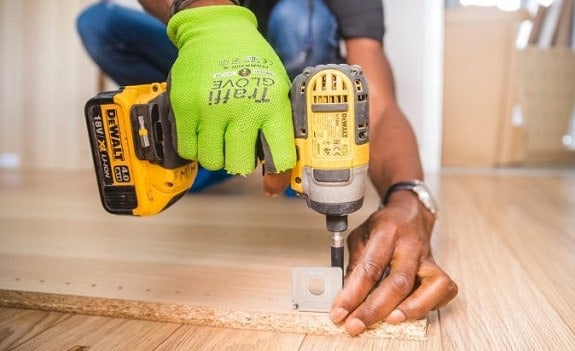Your DIY Beehive plans should enable the bees to go about their activities in the most natural way possible, yet in a way that allows you to check in on them and harvest without destroying the colony as a whole.
What beehive should you start with?
That’s one of the many questions you’ve had to ask yourself now that you are interested in beekeeping.
The beehive is where nature meets convenience.
Although hives come in different colors and shapes, the basic design falls into one of three main categories: Langstroth, Top Bar, and Warre.

DIY Langstroth, Top Bar, and Warre DIY Beehive Plans (& Bee Accessory Plans)
Over time, people have added a splash of creativity and pizzazz to the basics and come up with all sorts of hives that are beautiful on the outside yet functional on the inside.
Without further ado, let’s take a look at these DIY beehive plans to help you build your own beehive.
DIY Long Langstroth Beehive Plans
This is like a mash-up of the top bar and the Langstroth.
The design of the hive box and frames is inspired by the Langstroth hive, while the horizontal setup and use of burlap above the frames are borrowed from the top bar.
This DIY Beehive is built to be at a comfortable height so that you don’t bend when paying the girls a house call.
The burlap helps to keep your bee colony calm by only exposing the frames you want to work on.
It may need a little extra stability because of its height, you need to either strap it down or place something heavy on it to keep it from toppling over when there are strong winds.
The design is great and demonstrates the optimal use of space.
Layens Beehive Design
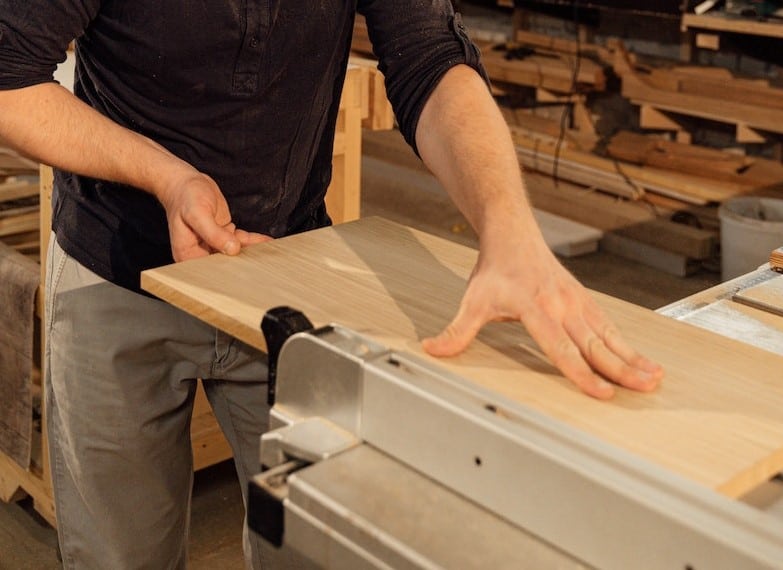
This is another horizontal design that is similar to Langstroth hives, with one exception.
The frames are very long vertically, so it almost looks like a regular bee hive that has been turned on its side. It is, however, much bigger.
It can be designed to hold 12 to 30 frames. A 14-frame Layen hive is the equivalent of 18 Langstroth deep frames and can hold approximately 45 lbs of surplus honey.
There are over 1 million of them in use, so they are quite popular.
Double Deep Long Hive
This DIY Beehive is like a double-decker bus with two rows of standard deep frames. The design can hold 52 deep frames, 26 on each level.
The downside of some larger frames is that finding an extractor to accommodate the extra dimensions can be a pain.
This hive allows you to use your regular harvesting equipment with the benefit of reducing the strain on your back.
Layens Swarm Trap
This swarm trap is similar to a nucleus hive. It accepts 6 Layen frames, which are much longer than the standard frames. The build is similar to the Layen hive, just a little smaller.
It goes without saying that once you start off with a Layen swarm trap, it is best to transition your bee colonies into a Layen hive because moving the brood to a smaller hive would be problematic.
The size and dimensions of this trap make it a little tricky to handle if it is suspended, so consider that when deciding where to place it.
You can build this DIY Beehive to accommodate 6 or 7 frames.
Gable Roof Hive Top
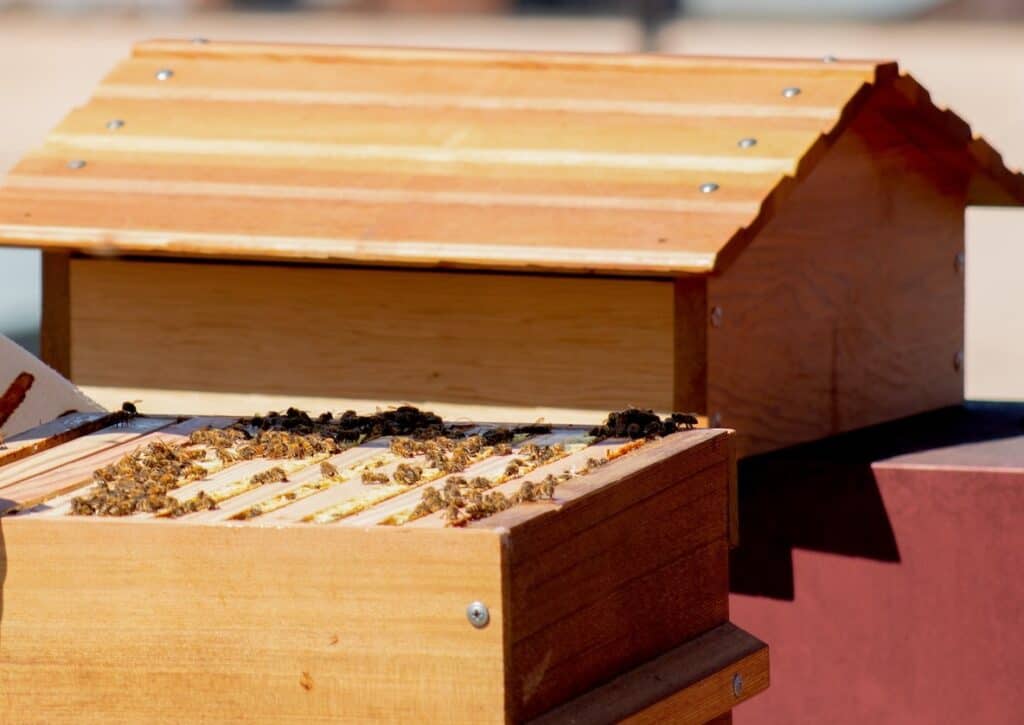
The gabled roof hive top is a great accessory that you can use on any hive type.
These particular beehive plans are designed for a horizontal hive, but you can adjust the length for any other type of bee hive.
It keeps rain and snow away from the entrance of the hive box, which means you don’t need to worry about placing your hive on a slight incline.
These plans also include insulation under the inner cover, which is very important during the winter and allows moisture to escape. This keeps the bees dry during the cold months, which helps to keep them alive.
Lite Swarm Trap Plans
Swarm traps are great for capturing free swarms.
This design holds six standard Langstroth deep frames. It’s light enough to mount on a tree, and dismounting it won’t be too problematic.
It’s a quick build and much cheaper than buying more bees.
Plywood Hive
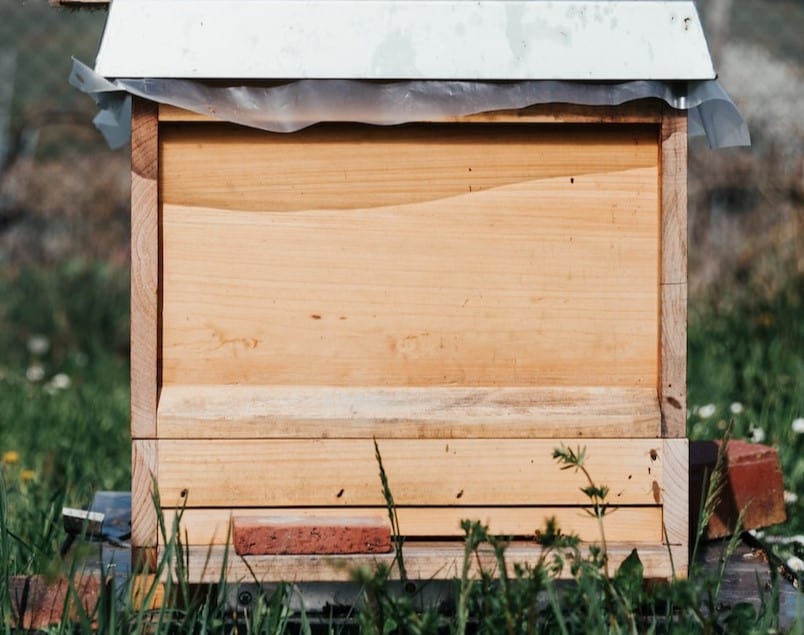
This build is a standard horizontal Langstroth-type hive. It can house 24-26 extra deep frames, depending on the spacing you choose between the frames.
The build includes options for insulating the walls of the hive if you live in colder regions.
The insulation can be permanent or temporary, allowing you to take it off in the summer. The insulation used, polystyrene, also helps to absorb excess moisture during the winter.
The build is done with plywood, which is strong but light. There is an option to assemble the hive with only screws, which means you can take it apart for transportation.
Alternatively, use glue if you’re sure that the placement of the hive is permanent.
Cathedral Hive
I give this build an A for ingenuity.
The pretty cool shape of the bars encourages the bees to build their comb in the shape of a hexagon like they do their cells. It’s really beautiful.
This is a great hive for anyone who keeps bees for pleasure based on the top bar type of hive.
Golden Mean Top Bar Hive

This is a top bar hive with a viewing window, which allows you to keep an eye on them between inspections in a non-invasive manner.
The top bars are shaped in such a way that they guide the bees to build along the entire length of the hive, maximizing the space.
The fully assembled hives also include follower boards that give the bees somewhere to hang out when it gets too hot without smothering the brood.
It is topped off with a gabled ventilated roof.
Hexagonal Beehive Warre Style
This is a beautiful albeit complex build that attempts to mimic the most natural shape of the natural beehive: a tree.
Okay, most trees are cylindrical, but bees have shown us that they favor the hexagonal shape, so who’s to say that they wouldn’t love a hexagonal tree?
The Warre hive is favored by naturalists. Inspections are done two or three times a year.
Additional boxes are added below the brood boxes, allowing the bees to draw comb downward like they naturally do.
As they do that, the queen lays her eggs in the new wax, and the old wax, now above the brood, is filled with honey.
That allows the beekeeper to cut out old wax, which may contain chemicals brought to the hive by bees as they forage.
Beautiful and practical.
Top Bar Fridge Bee Hive Build
This is the Macgyver build of the bunch and brings new meaning to the word recycling.
There’s nothing simple about this build, but it is an adventure.
Fortunately, there is proof of concept, so if you have an old fridge gathering dust and occupying space in your garage, why not turn it into a colony’s new home.
Vertical Observation Hive
In the bee world, they keep all their trade secrets in the hive.
When we inspect the hives, we see evidence of what they have been up to, but we don’t get to see them in action. You can change that with this build.
It’s a little unconventional in the arrangement since it is a vertical arrangement, but it offers you a rare opportunity to be part of their everyday lives.
You can watch the nurse bees tend to the young and possibly catch the queen in action. It’s a great learning tool for you and those around you.
Mini Nucleus Hive
This is an important asset to have if you choose to start breeding queens. It has room for three frames, so it’s easy on the pocket, and it’s a pretty easy build.
The size allows you to make two or three nucleus hives that you can use to overwinter struggling colonies and then combine them in the spring.
Breeding your own queen doesn’t just save you money. It also maximizes some of the local traits that the bees in your area may have developed.
Bees that come from completely different climates don’t tend to last long, so having a locally bred queen increases your chances of queen acceptance and survival.
Simple Langstroth Bee Hive

Most beekeepers prefer to start with a Langstroth hive. It’s a popular design because it is quite user-friendly.
This design allows you to start off with a simple hive with all the basic components, including a screened bottom board. That’s a necessity these days, with the Varroa Destructor causing havoc all over the place.
It comprises a deep box, a super, an inner cover, and a telescoping cover.
They have an added feature that allows for ventilation and ensures that rainwater flows away from the entrance of the hive.
That means you don’t need to worry about placing your hive on an inclined surface. If you’re just starting out, this is a great DIY Beehive to build.
Standard Langstroth Hive Made With Wooden Pallets
Wooden pallets aren’t just good for making stands. You can use them to make hives.
If you have old wooden skids laying around, they are a cheap source of materials. They are quite sturdy, giving you a stable structure when built well.
This plan is for a standard Langstroth hive. It provides for options to have either top bar frames or enclosed frames.
The build is quite basic with simple joints, so you can put it together quite quickly and direct the savings toward other equipment.
Budget National Beehive
This design is based on the National hive, popular across the pond. The hive holds 48 frames, 24 are deep, and the rest are shallow frames like those found in a regular super.
To reduce the workload, levels are created within the same box. That way, instead of having 4 different boxes, each with twelve frames, you have two boxes, each having two levels of frames.
For that to work, one of the walls has to be removable. It costs almost a fifth of the price of a regular National hive, so it’s a good way to start off your project.
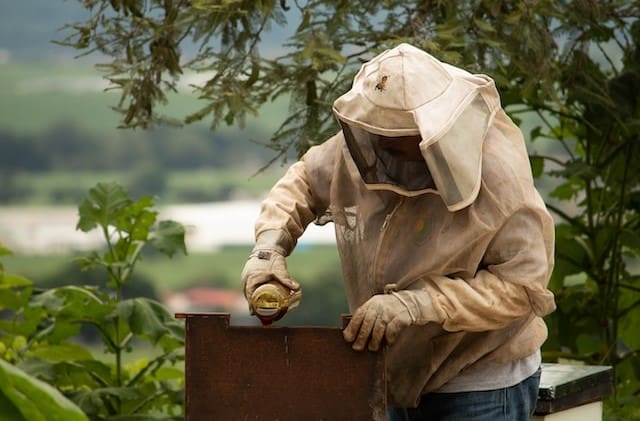
Plywood Honey Bee Swarm Bait Catch Hive
Swarming is a natural source of colonies. Although beekeepers try to suppress the bees’ urge to split, the colony can choose to be defiant and swarm anyway.
That’s not always a bad thing, especially if you have bait hives in place to provide a colony with a new home.
The wood used in this build is plywood. Everyone and their grandmother probably have an opinion on what wood is best, but there are benefits to this cheap material.
It is light in weight, so hoisting it up and retrieving it is relatively easy. It’s easy on the pocket and makes for a quick build.
The downside is that it offers little insulation, so you would need to wrap it up if you happen to use it in the winter.
It holds enough space for 6 standard national frames, which is why it is popular in the U.K.
Colorado Top Bar Hive
Forget the garden gnome; this is just the artifact missing from your backyard.
The design is based on the Kenya Top Bar hive, but it has some aesthetically pleasing features that add a little pizzazz to your yard.
This is a top bar hive, so no need for closed frames. The use of wedges and slots to keep the side panels connected to the front panels adds to the stability of the build.
In addition to that, the legs are part of the front and back panels so which reduces any points of weakness.
The only downside is that it is quite low. Fortunately, being a top-bar hive, you won’t need to lift any heavy supers, so your back is still safe.
Honey Bee Swarm Catch Hive
When you come across a swarm, sometimes all you need is something very temporary to get their attention.
It is not intended to be a temporary home. Just a truck stop, if you will. This cardboard box provides that kind of service to a swarm looking for a new place.
As you can imagine, cardboard isn’t built for longevity, so this one is ideal for baiting a swarm and promptly relocating it into a hive or a nucleus. It is wrapped in polythene to protect it from falling apart outdoors.
It only has one frame, preferably with some old brood comb. That scent appeals to bees, probably like the smell of cookies in the oven.
That homey smell will attract a swarm’s attention, and soon after, you can take your box and pour the bees into a more permanent structure.
Quick, easy, cheap, and effective.
Langstroth Movable Frame Hive
One major benefit of standardized hive parts is the ability to replace different hive parts easily.
If the bees get a little enthusiastic with their propolis and you accidentally break a frame while trying to pry it loose, finding a frame to replace it becomes easy.
This DIY Beehive guide is intended for just that.
The dimensions provided are based on the standard measurements for the various components of the hive. This ensures that you can make spare frames, supers, bottom boards, and telescoping covers that will be compatible with your hives.
The measurements used in this guide are based on Canadian standards.
Top Bar Beehive from Hobby Farms
If you are no stranger to a 9-5 workday, then this DIY beehive will take you just one day.
You can repurpose old lumbar for this build which makes it a very affordable option for you. The top bars can vary in width depending on your preference or time of year.
This design focuses on the hive body. The stand will be up to you.
It can be as simple as cinder blocks which they have the hive resting on, or you could make some legs for it. This is perfect for the hobbyist.
You can appreciate the bees not for what they can give you as an individual but for what they have been doing for mankind.
Hive Bodies
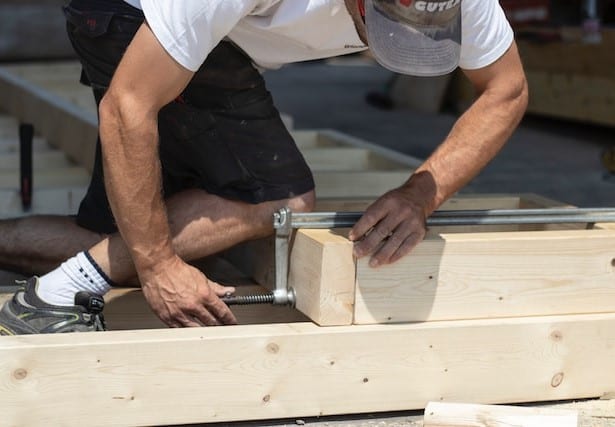
When you buy a typical Langstroth hive, it comes with one brood box, one super, one cover, and a bottom board.
If you’ve done your homework, you probably know that hives come in different configurations depending on where you live.
Some will have two medium-deep brood boxes and several supers.
Since the configuration depends on the location and purpose of the bees, you may not start off with all the boxes you need. For instance, if you have a colony that you rear to provide swarms, then it probably doesn’t need as many boxes as the one you keep for pollination services or honey production.
This build allows you to make additional boxes that are sturdy and durable, depending on your needs.
The author of this design chooses to paint inside the hive, which is a move that I don’t agree with, but everything else about this build is fantastic.
I like the joint used because it adds to the strength of the structure.
Styrofoam Nuc
This is an unconventional build.
Sure, we prefer to keep bees in natural materials such as wood. But bees are capable of setting up shop wherever they find space.
Of course, they abscond when they are truly unhappy, but there are ways to get them to stay put. I say this because this nucleus hive is made of polystyrene. Polystyrene is light and will keep the bees warm.
This nuc isn’t just intended for small colonies. You can use it to hold your frames as you carry out inspections.
If you are like me and you started off with stands that are only big enough to hold one hive, then this build is going to work wonders for you.
You’ll have a lightweight assistant who can hold your frames for you as you carry out your inspection. Ensure the dimensions of the nuc match those of your existing frames.
One thing to note is that you should insist on extruded polystyrene rather than the white beaded foam type that you probably see.
Mini Nucs
If we’ve learned anything from bees, it’s that big isn’t always better.
These tiny insects are responsible for keeping the world’s population well-fed. Without them, we are not likely to last more than a few years.
Following in those footsteps, there are beekeepers who want to see how small they can get to be effective. Thus the mini-nuc was born.
This miniature hive is ideal as a source of brood or raising queens. The space occupied by a medium-deep brood box can house four miniature nucs.
The build is very similar to a regular hive with a few modifications. For instance, the frame will be half the length of your standard frame, but the concept of bee space remains the same.
I’m sure you are concerned about transitioning brood frames to a regular-sized hive. Well, worry no more.
The build also covers a pin that you use to support the edges of the frames when transferring the brood to a regular hive. The bees will barely notice the difference.
This one is very economical. You will have 4 small colonies where you would otherwise have one. As a result, they need to be heavily supervised.
Because of the confined space, they can quickly run out of food, so you will need to supplement their nutrition with syrup or make arrangements to super your nucs.
Mason Jar Beekeeping
Interested in having chunky honey? This is the hive for you.
Chunky honey is where you have a large piece of honeycomb with capped honey in a jar, and then top that off with liquid honey.
The best part about using this design is that the bees do most of the hard work for you.
They build the comb inside the Mason jar, so there’s less damage done to the packaging, especially if you choose to sell or gift it.
There are a few special considerations to keep in mind. Glass can get hot very easily, so your hive should be placed in a cool area.
The jars must snugly fit in the holes. If they don’t and the bees get past them into the super body, they could build comb around your mason jars and create a big mess.
The plywood you use needs to be thick enough to hold the weight of the mason jars.
Build It ALL, Yourself
For those of us gifted with a craftsman’s touch, this is a DIY paradise. This is a one-stop shop for most of the plans you need to outfit your apiary.
From Langstroth hives and nucs to honey extractors and pollen traps, they have them all.
The only catch is that you can’t start a business selling any of these builds. They are only intended for you to build and use. To be honest, that’s where the fun is anyway.
The DIY Beehive plans are available in PDF, so you can download and print them without worrying about their readability.
The Warre hive is often recommended as a relatively easy, low-maintenance option for beekeeping. Every design has a little twist that makes it easier or better for the author to interact with the bees.
This particular design is smaller than your typical Langstroth, so it requires less material and less time.
This also means that it’s easier on your wallet than some of the other builds you may try. The author offers some helpful construction tips that will reduce accidental damages.
The use of pictures in the list of tools and materials is particularly helpful for construction beginners.
Assembly of the hive takes a few hours, so it’s definitely worth a try.
Build Your Own Beekeeping Equipment
Many of the free builds you find online are from a beekeeper’s perspective.
This one has the added advantage of being brought to you by a master craftsman who happens to love bees just as much as you do.
Tony Pisano, the author, has been building things out of wood for decades. His love of bees came much later.
So, the book is not about bees, but the design is outlined with the principles of beekeeping in mind.
The book is simple to follow and can be used by amateur builders whose saw still has that hardware store smell.
He is very detailed, which allows beginners to follow through with the build.
If you have tried the free plans and they didn’t work for you, this is definitely the book for you.
Building Beehives for Dummies
Where would we be without the Dummies Series?
This one offers instructions on how to make most types of hives, such as Langstroth Hives and Top Bar hives.
It seems to be geared toward experienced woodworkers and goes into a lot of detail. It will be a great addition to your book collection.
DIY Top Bar Beehive
This is another one for the amateur craftsman.
The Top-Bar Hive causes less disruption to the bees when you open it because the top bars have no spaces between them.
That means that they don’t all rush at you all at once when you check in on them.
That’s just one of the reasons why hobbyists love these hives so much. The other motivator is that they are quite affordable to build.
If your decision to have a colony nearby is pollination, then it doesn’t make sense to splurge on an expensive hive when something simple and functional will do.
The author has included a video where she elaborates on the build and the various obstacles that she overcame.
If you are looking for simplicity, this is a good one to start with.
Honey Bee Box

A honey bee box is just another name for a hive. The plans don’t show you how to build the entire hive, just the boxes that hold the frames. That’s a valuable skill to have because you will always need additional boxes.
One of the reasons I use them is to change the wax.
Every few years, I like to change the comb in the brood box, which helps to eliminate any dissolved chemicals in the wax.
To do this, I need a brood box with all the frames. The empty box can be placed below the existing brood box as you would with a Warre hive.
Once they build a new comb, they also concentrate on having brood in the new comb. The transition is made easier if you have a spare box.
They recommend that you buy the other parts of the hive because those are a little more complicated to make.
You’re free to disagree.
The Great Alaskan Top Bar
This Top Bar hive design is ideal for the weather in the colder Northern states.
If you leave in an area with long, harsh winters, then this would be a good one to try.
For a small fee, you get great quality plans for a top-notch hive. The plans come with a hive stand design, a gabled roof, and a viewing window.
It is made to be sturdy, beautiful, and functional, which is a winning trio.
Honey Super Plans
Here’s why I wish I was as industrious as a bee. As long as nature is producing nectar and the bees find it, they will continue to store it. The more space they have, the more they put away.
Well, there are terms and conditions, of course. You need a healthy colony that is capable of taking advantage of the increased demand.
So, if you decide to purchase your first hive, and you happen to live in a flower-rich area, you will be doing yourself and your colony a great disservice if you don’t give them more space.
These plans are easy to follow and provide measurements in both the metric system and the imperial system, so you’ll be covered one way or the other.
Dandant Type Frames (for Langstroth Hives)
If you’re looking to beef up your stock of spare frames, then this is a good place to start. If you don’t think you need more frames than you currently have, I’d beg you to reconsider.
Sometimes, the bees can be very generous with their use of propolis. They can really glue down those frames.
With time, as you use your hive tool to pry them loose, they will chip, and they will break.
If you leave them with that extra space, then they build comb where you don’t want them to. It’s best to have a few, just in case.
This design comes from people with several decades of experience and a thriving business as a testimony to their products.
This DIY Beehive is a delicate build, so you will need some practice to do this well.
Modified OATH Hive
Let’s step away from the honey bee for a moment and meet its honey-producing cousin. This one is known as the Trigona stingless bee.
This DIY Beehive caters to these stingless bees that are smaller than the honey bee and live in colonies but do not sting.
They prefer to attack your orifices, like your nose and mouth, by invading them.
Once again, this is not a species native to the U.S. and is not known to thrive in cold climates.
However, just south of the border, they have found a home. Yes, you can find them in Mexico.
The hive is small, so you could build it, move to a state near the border and see what happens. Alternatively, you can make it as a gift and share it with an Australian friend.
Common Types of Beehives
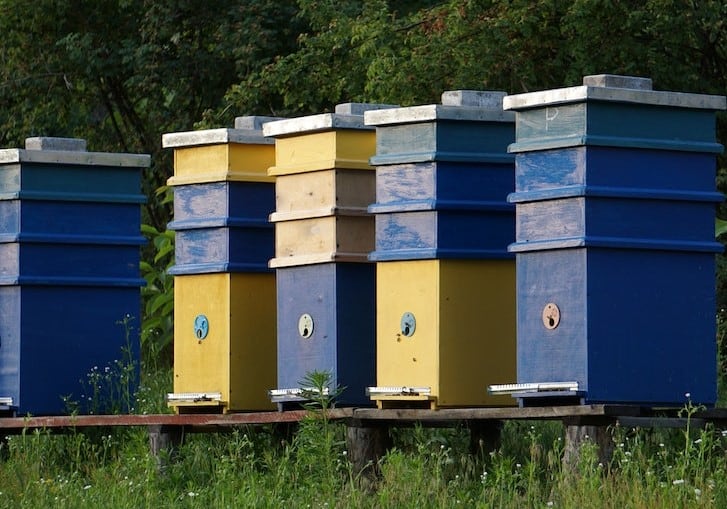
Langstroth hives
The preferred choice of many. Because so many beekeepers prefer this design, it is readily available, and so are the accessories that go with it.
Even the Flow hive that has created a lot of buzz in the last few years is a Langstroth hive with a modified harvesting system.
As the colony grows, additional boxes are stacked up. Typically, it is known as a vertical hive, but there are horizontal Langstroth hives in use.
With the exception of the flow hive, there’s a lot of heavy lifting during a harvest with the Langstroth hive.
Lifting supers filled with honey can be dangerous for your back. When working with the stacked boxes, you may find yourself bending a lot when inspecting the brood boxes.
Despite these disadvantages, the productivity of the colony seems to be optimal when using these types of hives.
The Top Bar Hive
Also known as the Kenya Top Bar Hive, it is a horizontal hive. It gets its name from the bars used as starters for the bees to construct their comb.
Unlike the Langstroth, this hive doesn’t use frames, just a strip of wood known as a top bar.
Every DIY Beehive is different, so there is no standard for a top bar hive. It’s ideal for the hobbyist because opening up this hive causes minimum disruption to the bees.
Honey production isn’t very high, but you can get enough to get by. Most people build their own, and maintenance is minimal, so it won’t take too much of your time.
The Warre Hive
It is a little like the top bar hive in that it doesn’t use frames and a little like the Langstroth because it involves stacking the boxes horizontally.
It has even fewer maintenance requirements than the top bar hive but a lot more heavy lifting. The difference is that the lifting is done once or twice a year.
Final Thoughts
If your heart is set on beekeeping, then don’t let price tags keep you away.
There are lots of DIY options that could be just as good as the store-bought hives yet kinder on your pocket. You can start with any of the options here.
